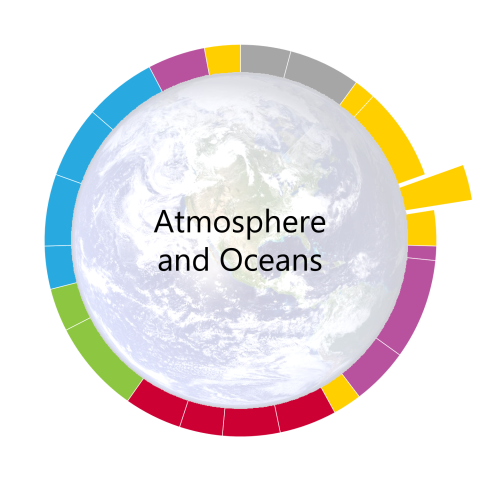
Phenomenon
The Earth is a unique planet, even among its neighbors in the inner solar system, having not only a rocky structure but also oceans, an atmosphere and life! We've figured out how the rocky core of Earth formed, but we are still wondering about the other three "spheres" -- hydrosphere (oceans), atmosphere, and biosphere (life).
Question
Where did Earth's oceans and atmosphere come from?
Model Ideas
- The Earth was formed from space rocks, so the water for the oceans and gases for the atmosphere must have come from space rocks.
- There’s plenty of water in space rocks to have filled the Earth’s oceans.
- Volcanoes released and continue to release water vapor and gases from the interior of the Earth.
- Gases released from volcanoes thus created the atmosphere too.
- The water vapor (a gas) condensed and formed the oceans.
Overview
Transition In: After developing a model for the formation of the geosphere, we turn our attention to the other aspects of Earth, the ones that make it more pointedly unique--the atmosphere, the oceans, and life. How did these originate?
We remind ourselves of a few lingering questions about the formation of Earth and decide to next focus on the oceans and atmosphere. In offering some initial ideas, we come to the logical supposition that the air from the atmosphere and the water that fills the oceans came from the very space rocks (meteors and comets) that built Earth's rocky geosphere. But is it possible that rocks contain water, and furthermore, enough water to fill the oceans. Through a lab, we recognize that rocks in fact do contain water, albeit in miniscule amounts. We also read about the typical low water content of a meteor. But in recognizing that the mass of the oceans is a tiny, tiny fraction of the mass of the Earth, we begin to see how our model idea makes sense.
We next wonder how so much of the water made it to the surface. In studying volcanic outgassing as a possibility, we also stumble upon a mechanism for the formation of Earth's atmosphere. It would seem, then, that the hydrosphere (oceans) and atmosphere came out of the molten geosphere. We conclude the unit by writing an explanation for the formation of the Earth using our new model ideas in combination with the model we developed in the last unit.
Transition Out: After imagining an Earth with both atmosphere and oceans, we recognize the stage has been set for the evolution of life. But we're still wondering when and how life comes to out planet.
Advanced Planning
There's little preparation for this unit beyond one demo/laboratory and an optional check-in about Human Impacts. (See the end of the Learning Segment Table below and the PowerPoint for details on this latter activity.) The goal of the gypsum lab is for students to recognize that water can be stored in rocks. Read the preparatory and purchasing notes here and in the laboratory Teacher Guide and make sure your room is well ventilated. Gypsum can have a strong “fertilizer” odor.
Download Resources
| Attachment | Size |
|---|---|
| All Resources for Atmosphere and Oceans | 14.98 MB |